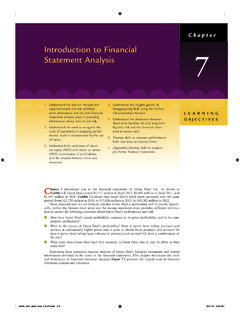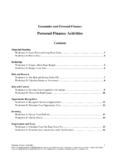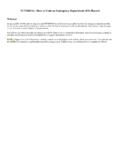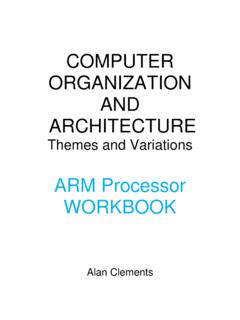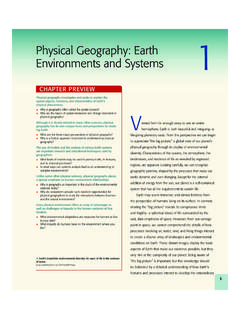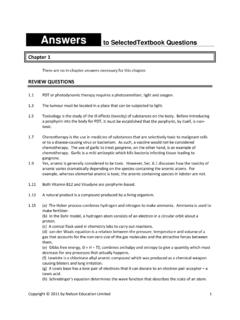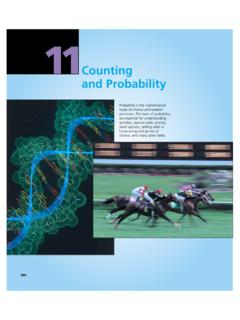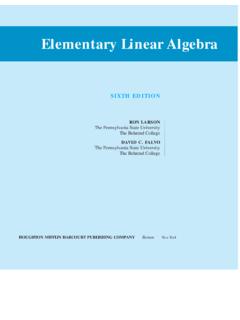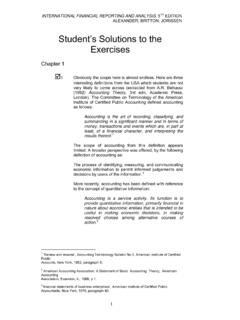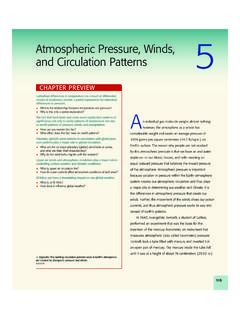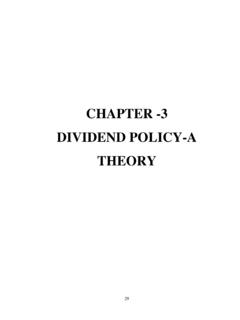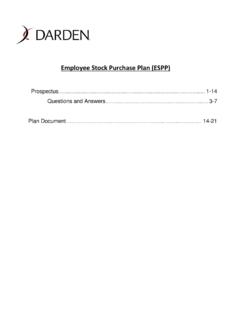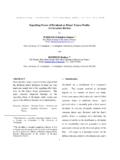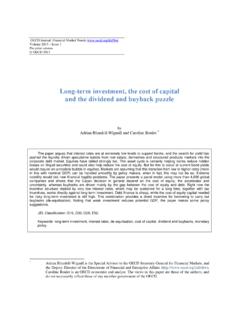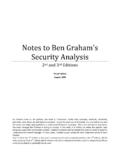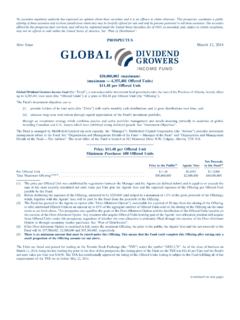Transcription of Chapter 13 Dividend Policy - Cengage
1 67 Chapter 13 Dividend PolicyAnswers to Concept Review Questions1. What policies and payments does a firm s Dividend Policy consist of? Why isdetermining Dividend Policy more difficult today than in decades past?A firm s Dividend Policy refers to its choice of whether to pay out cash to shareholders, inwhat fashion, and in what amount. The most obvious and important aspect of this Policy is thefirm s decision whether to pay a cash Dividend , how large the cash Dividend should be, andhow frequently it should be distributed. In a broader sense, Dividend Policy also encompassesdecisions such as whether to distribute cash to investors via share repurchases or speciallydesignated dividends rather than regular dividends, and whether to rely on stock rather thancash distributions.
2 Non-traditional forms of Dividend payments, especially share repurchasesare much more commonly used today, and so the Dividend decision is much more complex anddifficult than in the past. Also, there are many more important categories of shareholders whomust be satisfied today especially institutional investors whereas managers once merelyhad to satisfy individual What do you think is the typical stock market reaction to the announcement that a firmwill increase its Dividend payment? Why?An increase in the Dividend payout is considered to be good news. The firm isdemonstrating that it not only has positive cash flows, but these cash flows are increasingenough to justify a higher payout to shareholders. The firm proves its cash flow bypaying out some of that cash to its shareholders.
3 Higher dividends may signal permanenthigher earnings for the firm3. Assume you are the sole owner of a profitable private corporation. What do youthink would be the most tax-efficient method of receiving ownership income (via salary,perks, retained earnings, or dividends)?As the sole owner of a corporation, the best method of receiving income would be viaretained earnings. These are taxed once at the corporate level. The second most costefficient method would be salary--these are taxed at the personal level but are a tax-deductible expense to the corporation. Dividends are the least efficient--these are taxedboth at the corporate level and at the personal level. With perks, it would depend on thekind of perk. Some may be considered company expenses, and not taxed to theindividual.
4 The sole owner would presumably invest in the perks that were mostimportant to him or Why should we expect a firm s stock price to decline by approximately the amount of thedividend payment on the ex- Dividend date? Why do stock prices generally fall byless than the amount of the Dividend payment?The firm has removed an amount of cash equal to the amount of the Dividend from thefirm. It s total assets have declined, so its market capitalization and, in turn, the stockprice should decline by this amount as Y Chapter 13/ Dividend Policy5. How do average Dividend payout ratios for companies headquartered in English commonlaw countries compare to those of companies headquartered in civil law countries? Whatexplains this difference?With the exception of the companies, firms headquartered in English commonlaw countries (Britain, Canada, Australia, New Zealand, etc) tend to pay out significantlyhigher fractions of their earnings as dividends than do companies headquartered in civillaw countries.
5 The Law and Finance explanation for this is that common law providesmuch greater protection to small investors than does civil law, and thus shareholders areable to demand higher Dividend payments in common law countries. Firms in civil lawcountries do not face such effective demand from shareholders and are more able toignore their preferences for higher Can you provide an answer to the following question: If high- Dividend stocks offer ahigher expected (and required) return than low- Dividend stocks due to higher personaltaxes levied on the former, why don t corporations simply reduce Dividend payments andthus lower their cost of capital? If the cause and effect were this simple and this was the only factor then firms couldreduce Dividend payments to lower their cost of capital.
6 In reality, the relationship ismore complex. First, using return on equity x retention ratio as an approximation ofgrowth, lower Dividend payouts means higher retention and higher growth. A highergrowth means a higher, not a lower cost of capital. If firms reduced their Dividend theywould need positive net present value projects to invest in to satisfy investors. If theytook the reduced Dividend and invested in treasury securities (negative net present valueinvestment for the corporation), then shareholders would sell their shares and invest in avalue-maximizing Which industries are characterized by relatively high Dividend payout ratios? Arethese same industry patterns observed in other industrialized countries? What explainsthese industry patterns?
7 Utilities, transportation companies, financial institution and companies involved in heavymanufacturing firms tend to have high leverage and high Dividend payouts in allcountries, while service firms, high-technology companies and firms with highly variableearnings ( , mining) tend to have little or no debt and have low Dividend payout pattern of Dividend payouts is explained by the same factors that influence capitalstructure decisions: regulated companies and firms with stable cash flows and stableasset bases tend to have high leverage and high payouts. Companies operating in avolatile industry or which must make ongoing and high-risk discretionary investments innew technologies have little or no debt and low Dividend What is the basis of the argument that transactions costs provide a reason for firms to paydividends, and what light has the steep decline in transactions costs in recent years shedon this argument?
8 You could look at companies with high payout ratios, and look at how much externalfinancing they raised, along with the flotation costs of that financing. You would look tosee if firms with higher Dividend payouts had more or less external financing. Was itlower cost debt financing or higher cost equity financing? If a company s transactionsChapter 13/ Dividend Policy Y 69costs for external financing were higher than average, did they have a lower thanaverage payout ratio to minimize their need for external financing?9. What does it mean to say that dividends are irrelevant in a world without taxes or othermarket frictions? Dividend irrelevance means that a firm s decision whether or not to pay a cashdividend cannot impact the value of that firm s stock in a world without market can create their own dividends (cash income) by selling shares, so they findno benefit in receiving dividends.
9 Likewise the firm can either pay or retain cash, but if itpays dividends out the firm must sell new shares to make up the cash flow , the company s stock price will be based on the stream of profits generated bythe firm s existing assets and its new investments, not on how it finances itself (throughretention or new share issuance).10. Managers of slow-growing, but profitable firms ( , tobacco companies) should pay outthese high earnings as dividends. What might they choose to do instead?If managers of profitable companies kept their earnings instead of paying them out asdividends, they might invest in negative net present value projects. If they are in a lowgrowth industry, and do not have good uses for their earnings, they might be tempted toincrease the size of the company by buying other companies.
10 If there are no particularsynergies benefits of the two companies being together rather than operating separately then the acquisition is not value increasing and should not be How do Miller and Modigliani (M&M) arrive at their conclusion that Dividend Policy isirrelevant in a world of frictionless capital markets? Why is the assumption of fixedinvestment Policy crucial to this conclusion?They show that shareholders of a non- Dividend -paying firm can duplicate any givenpattern of Dividend payments made by a company by simply by selling off a fraction oftheir holdings each period. If one company pays dividends and another comparable firmretains its earnings, then the Dividend -paying firm must issue new stock equal to theamount of the Dividend in order to continue being truly comparable to the retention one maintains the assumption of equal investment amounts each period, theretention firm will grow steadily larger than the Dividend -paying firm over time.
